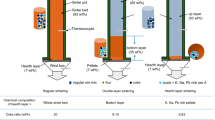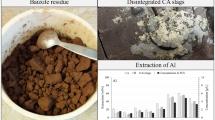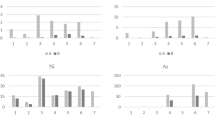Abstract
Coal is one of the most available energy sources on earth. The mineralogical and geo-chemical aspects of coals are of prime importance for their utilization. The mineralogical composition, ash chemistry, and ash fusion temperature (AFT) ranges of raw and beneficiated coals are investigated in this paper. Further, the mineral matter transformation during the beneficiation processes viz. by oxidative desulfurization; alkali extraction and ultrasonication along with the relationship of the ash fusion temperature (AFT) ranges with the ash components in the coal are discussed. The major oxides present in the coal and beneficiated coal ashes include Fe2O3, Al2O3, SiO2, CaO, and MgO, which significantly affect the ash fusion temperature ranges. Initial deformation temperature (IDT) changes with the ash components and, increases with the increase in the Fe2O3 content in coal ash. With increasing concentrations of both Al2O3 and SiO2, the initial deformation temperature (IDT) also increases. The increasing and decreasing nature of the initial deformation temperature (IDT) observed is also dependent upon the CaO and MgO contents. XRD analysis of the coal samples revealed significant changes in mineral matter contents with the types of beneficiation processes adopted for coal. The minerals like chlorite, illite, montmorillonite, pyrite, calcite, aragonite, and alumina have been removed during the beneficiation processes. The FTIR spectra also indicate the presence of minerals like gypsum (G), calcite (C) aragonite (Ar), quartz (Q) and kaolinite (K) in the raw coal and their subsequent removal after the beneficiation processes.
Similar content being viewed by others
References
Ahmed, M. (1996) Petrology of Oligocene coal, Makum coalfield, Assam, northeast India. Internat. Jour. Coal Geol., v.30, pp.319–325.
ASTM (2011b) Annual Book of ASTM Standards. Test Method for Ash in the Analysis Sample of Coal and Coke, ASTM International, West Conshohocken, PA.
Astm (1991) Annual Book of ASTM Standards; Coal and Coke. Standard Practice for Ultimate Analysis of Coal and Coke, v.05.05.
Astm (2002) (Reapproved 2007) Test Methods for Total Sulfur in the Analysis Sample of Coal and Coke, ASTM International, West Conshohocken, PA,2011.
ASTM (2011a) Test Method for Moisture in the Analysis Sample of Coal and Coke, ASTM International, West Conshohocken, PA.
ASTM. (2011c) Test Method for Volatile Matter in the Analysis Sample of Coal and Coke, ASTM International, West Conshohocken, PA.
Astm. (2013) Standard Test Method for Gross Calorific Value of Coal and Coke, ASTM Volume 05.06 Gaseous Fuels; Coal and Coke, Bioenergy and Industrial Chemicals from Biomass.
Baruah, B.P. and Khare, P. (2007) Desulfurization of Oxidized Indian Coals with Solvent Extraction and Alkali Treatment. Energy and Fuels, v.21, pp.2156–2164.
Baruah, B.P., Sharma, A. and Saikia, B.K. (2013) Petro-chemical investigation of some perhydrous Indian coals. Jour. Geol. Soc. India, v.81, pp.713–718.
Belkin, H.E., Zheng, B.S., Zhou, D.X. and Finkelman, R.B. (1997a) Preliminary results on the geochemistry and mineralogy of arsenic in mineralized coals from endemic arsenosis areas in Guizhou province, P.R. China; In: Fourteenth annual international Pitts-burgh coal conference, Bejing, China, September 23–27.
Belkin, H.E., Zheng, B.S., Zhou, D.X. and Finkelman, R.B. (1997b) Preliminary results on the geochemistry and mineralogy of arsenic in mineralized coals from endemic arsenosis areas in Guizhou Province, China. In: Proceedings of the 14th Annual International Pitts-burgh Coal Conference and Workshop, Bejing, China, September 23–27.
Dai, S., Ren, D., Tang, Y., Yue, M. and Hao, L. (2005) Concentration and distribution of elements in Late Permian coals from western Guizhou Province, China. Internat. Jour. Coal Geol., v.61, pp. 119–137.
Falcone, S.K., Schobert, H.H., Rindt, D.K. and Braun, S. (1984) Mineral Transformations during Ashing and Slagging of Selected Low-Rank Coals. Fuel Chemistry, v.29, pp.76–83.
Finkelman, R.B. (1994) Mode of occurrence of potentially hazardous elements in coal: levels of confidence. Fuel Processing Technology, v.39, pp.21–34.
Finkelman, R.B. (1995) Environmental Aspects of Trace Elements in coal. Energy and Environment, v.3, pp.24–50.
Goodarzi, F. (1987) Elemental concentrations in Canadian coals: 2. Byron Creek collieries, British Columbia. Fuel, v.66, pp.250–254.
Goodarzi, F. (2002) Mineralogical and elemental composition of Canadian feed coals. Fuel, v.81, pp.1199–1213.
Gul, A. and Uner, I. (2007) Relationship between ash fusion temperatures (AFT) and coal mineral matter in some turkish coal ashes. Jour. Ore Dressing, v.9, pp.33–39.
Himus, G.W. (1954) Fuel Testing, Laboratory Method in Fuel Technology, Penguin, London, pp.67–78.
Hower, J.C., Blanchard, L.J. and Robertson, J.D. (1998) Magnitude of minor element reduction through beneficiation of Central Appalachian coals. Coal Preparation, v.19, pp.213–229.
Huggins, F.E., Kosmack, D.A. and Huffman, G.P. (1981) Correlation between ash-fusion temperatures and ternary phase-diagrams. Fuel, v.60, pp.577–584.
Huggins, F.E., Seidu, L.B.A., Shah, N., Huffman, G.P., Honaker, R.Q., Kyger, J.R., Huggins, B.I., Robertson, J.D., Pal, S. and Serha, M.S. (2009) Elemental modes of occurrence in an Illinois 6 coal and fractions prepared by physical separation techniques at a coal preparation plant. Internat. Jour. Coal Geol., v.78, pp.65–76.
Indian Standard: 12891 (1990) Method of determination of fusibility of ash of coal, coke and lignite.
Khare, P. and Baruah, B.P. (2010) Elemental characterization and source identification of PM2.5 using multivariate analysis at the suburban site of North-East India. Atmospheric Res., v.98, pp.148–162.
Khare, P. and Baruah, B.P. (2010) Structural parameters of perhydrous Indian coals. Internat.l Jour. Coal Preparation and Utilization, v.30, pp.44–67.
Kim, A.G., Kazonich, G. and Dahlberg, M. (2003) Relative solubility of cations in class F fly ash. Environ. Sci. Tech., v.37, pp.4507–4511.
Kosminski, A., Ross, D.P., Agnew, J.B. and Kosminski, A. (2006) Reactions between sodium and silica during gasification of a low-rank coal; Fuel Processing Technology, v.87, pp.1037–1049.
Kryukova, V.N., Kindeeva, V., Baskova, L.V. and Latyshev, V. (1985) Arsenic in Eastern Siberian coals. Khimiya tverdogo topliva (Chemistry of Solid Fuels). pp.1129-232.
Kukier, U., Ishak, C F., Sumner, M.E. and Miller, W.P. (2003) Composition and element solubility of magnetic fly ash fractions. Environmental Pollution, v.123, pp.255–266.
Li, F., Huang, J., Fang, Y. and Wang, Y. (2011) The effects of leaching and floatation on the ash fusion temperatures of three selected lignites. Fuel, v.90, pp.2377–2383.
Liu, B., He, Q., Jiang, Z., Xu, R. and Hu, B. (2013) Relationship between coal ash composition and ash fusion temperatures. Fuel, v.105, pp.293–300.
Liu, Y., Gupta, R. and Wall, T. (2007) Ash formation from excluded minerals including consideration of mineral-mineral associations. Energy and Fuels, v.21, pp.461–467.
Manoj, B., Kunjomana, A.G. and Chandrasekharan, K.A. (2009) Chemical Leaching of Low Rank Coal and its Characterization using SEM/EDAX and FTIR. Jour. Minerals & Materials Characterization & Engineering v.8, pp.821–832
Mitchell, R.S. and Gluskoter, H.J. (1976) Mineralogy of ash of someAmerican coals: variations with temperature and source. Fuel, v. 55, pp. 90.
Moore, F. and Esmaeli, A. (2012) Mineralogy and geochemistry of the coals from the karmozd and kiasar coal mines, Mazandaran province, Iran. Internat. Jour. Coal Geol., v.96, pp.9–21.
Mukherjee, S. and Borthakur, P.C. (2001) Chemical demineralization/ desulphurization of high sulphur coal using sodium hydroxide and acid solutions. Fuel, v.80, pp.2037–2040.
Prachiti, P.K., Manikyamba, C., Singh, P.K., Balaram, V., Lakshminarayana, G., Raju, K., Singh, M.P., Kalpana, M.S. and Arora, M. (2011) Geochemical systematics and Precious metal content of the sedimentary horizons of Lower Gondwanas from the Sattupalli coal field, Godavari Valley, India. Internat. Jour. Coal Geol., v.88, pp.83–100.
Quann, R.J. and Sarofim, A.F. (1982) Vaporization of refractory oxides during pulverized coal combustion. In: Proceedings of 19th Symposium (International) on Combustion, v.19, pp.1429–1440.
Raask, E. (1985) The mode of occurrence and concentration of trace elements in coal. Fuel, v.11, pp.97–118.
Saikia, B.K., Dutta, A.M., Saikia, L., Ahmed, S. and Baruah, B.P. (2014b) Ultrasonic assisted cleaning of high sulphur Indian coals in water and mixed alkali. Fuel Processing Technology, v.123, pp.107–113.
Saikia, B.K., Goswami, R.L., Baruah, B.P. and Baruah, R.K. (2009) Occurrence of Some Hazardous Metals in Indian Coals. Coke and Chemistry, v.52, pp.54–59.
Saikia, B.K., Ward, C.R., Oliveira, M.L.S., Hower, J.C., Baruah, B.P., Braga, M. and Silva, L.F. (2014) Geochemistry and nanomineralogy of two medium-sulfur northeast Indian coals. Internat. Jour. Coal Geol., v.121, pp.26–34.
Schafer, H.N.S. (1970) Determination of total acidity of low rank of coals. Fuel, v.49, pp.197–213.
Sharma, D.K. and Gihar, S. (1991) Chemical Cleaning of Low Grade Coals through Alkali Acid Leaching Employing Mild Conditions under Ambient Pressure. Fuel, v.70, pp.663–665.
Sharma, J.N. and Wilson, M.J.G. (1961) The action of Alkali Solutions under Pressure on Coal. Fuel, v.40, pp.331–338.
Shivaprasad, K.H., Nagabhushana, M.M. and Venkataiah, C. (2010) Reduction of Ash Content in Raw coal Using Acids and Alkali. E-Jour. Chemistry, v.7, pp.1254–1257.
Singh, A.K., Singh, M.P. and Singh, P.K. (2013) Petrological investigations of Oligocene coals from foreland basin of northeast India. Energy, Exploration and Exploitation. v.31, pp. 909–936.
Singh, P. K., Rajak, P.K., Singh M. P., Naik, A. S., Singh, V.K., Raju, S.V. and Ojha, S. (2014) Environmental Geochemistry of selected elements in lignite from Barsingsar and Gurha Mines of Rajasthan, Western India. Jour. Geol. Soc. India, v.86, pp.23–32.
Singh, P.K., Singh, A.L., Kumar, A. and Singh, M.P. (2012) Mixed bacterial consortium as an emerging tool to remove hazardous trace metals from coal. Fuel, v.102, pp.227–230.
Singh, A.L., Singh, P.K., Kumar, A., Yadav, A. and Singh, M.P. (2014) Experimental study on demineralization of coal with Pseudomonas mendocina strain B6-1 bacteria to obtain clean fuel. Energy, Exploration and Exploitation, v.32, pp.831–846.
Song, W.J., Tang, L.H., Zhu, X.D., Yong, Q.W., Zhu, Z.B. and Koyama, S. (2010) Effect of Coal Ash Composition on Ash Fusion Temperatures. Energy and Fuels, v.24, pp.182–189.
Sulovsky, P. (2002) Mineralogy and chemistry of conventional and fluidized bed coal ashes. Czech Geological Survey, v.77, pp.1–11.
Swaine, D.J. (1990) Trace Metals in coal; Butterworth and Co Ltd, Oxford, UK, pp.27–66.
Vassilev, S.V., Kitano, K., Takeda, S. and Tsurue, T. (1995) Influence of mineral and chemical composition of coal ashes on their fusibility. Fuel Processing Technology, v.45, pp.27–51.
Vassileva, C.G. and Vassilev, S.V. (2002) Relations between AFTs and chemical and mineral composition of some Bulgarian coals. GEOLOGIE Mineralogie, v.55, pp.61–66.
Vogel, A.J. (1969) A Textbook of Quantitative Inorganic Analysis, Including Elementary Analysis, London, Longman.
Wang, W., Qin, Y., Wei, C., Li, Z., Guo, Y. and Zhu, Y. (2006) Partitioning of elements and macerals during preparation of Antaibao coal. Internat. Jour. Coal Geol., v.68, pp.223–232.
Wang, Z. Y., Ohtsuka, Y. and Tomita, A. (1986) Removal of Mineral Matter from coal by Alkali Treatment. Fuel Processing Technology, v.13, pp. 279–289.
Ward, C.R. (2002) Analysis and significance of mineral matter in coal seams. Internat. Jour. Coal Geol., v.50, pp.135–168.
Author information
Authors and Affiliations
Corresponding author
Rights and permissions
About this article
Cite this article
Saikia, B.K., Mahanta, B., Gupta, U.N. et al. Mineralogical composition and ash geochemistry of raw and beneficiated high sulfur coals. J Geol Soc India 88, 339–349 (2016). https://doi.org/10.1007/s12594-016-0496-4
Received:
Accepted:
Published:
Issue Date:
DOI: https://doi.org/10.1007/s12594-016-0496-4




